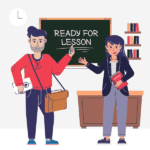Author: Seema Bhoi
Schools might be out of our lives for a while, but learning never will be. In that endeavor, schools have quickly turned around and adopted technology to ensure learning never stops. Thanks to the many collaboration-friendly tools which have been there for long, though more so for business purposes, the education world is not left deprived of its benefits even when the COVID-19 pandemic keeps disrupting all sectors of society.
Working together, storing information online, face to face classes are emerging and evolving in a big way as schools gear up to streamline the online learning process. Here is a look at what’s happening across the globe:
With an impressive roll call of 200 talented teachers, BBC has launched its Bitesize Daily service. This was done in a record time of 14 weeks and with collaboration between teachers and educational specialists, this platform is all set to provide curriculum-based education to children across the UK.
In South California, organizations like PBS SoCal and KCET have created educational broadcasts, PBS Learning Media, which will also stream educational content making them available on Roku and Apple, Amazon Fire TV, YouTube, and Google Play. This will give access to education to 700,000 LA students.
Education bodies and the government of India have launched many e-learning apps to support learning in these turbulent times. E-PathShala, DIKSHA portal, Swayam, and STEM-based games are some of the examples of such ventures.
The cloud solutions by many top-notch companies like Microsoft and Google are being utilized across the schools in the world for a seamless transition from the traditional classroom to a virtual one. Even the World Bank is in conversation with the ministries of education in various countries to catalog their approaches in its internal database. This will make such information available to those educational bodies that need it.
Some of the widely used platforms being:
MS Team – This provides interactive face-to-face sessions between teachers and students, means to share and store files, etc. The built-in Skype technology facilitates video discussions and teachers can send a message to a single student or the entire classroom. There is also an assignment management tool integrated within.
Zoom – Thousands of schools have shifted to this platform for virtual learning. With whiteboards, screen-sharing with annotation, and breakout room to split the meeting into multiple sessions, teachers can control their classes just the way they did in a typical classroom. One can record sessions to view later as well.
Google Classroom – If you want to have online assessments or enrich your teaching material with YouTube videos and Google form surveys then there is so much that this tool can help you with. With the paperless flow of assignments, making and assigning work is a breeze for the teachers using this app. Anyone with a Google account can go ahead and hold a Google classroom.
BrainCert – You can teach, learn, and collaborate from the same place with this tool. It has different platforms for its 3 different functions; a platform to create courses, content management, and an online testing system. With a powerful reporting and tracking system, this is a great tool for a virtual classroom.
With the boredom of one-sided lectures gone out of the way, students seem much more interested in this student-centric mode of learning. Their grades also reflect that these mediums are proving to be a success. Though a face to face interaction and its personal touch cannot be replaced in its entirety, it is imperative that learning continues for capacity-building of young minds and schools have realized and taken the much-needed digital route.
















